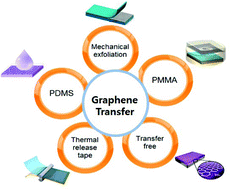Graphene transfer: key for applications
Abstract
The first micrometer-sized graphene flakes extracted from graphite demonstrated outstanding electrical, mechanical and chemical properties, but they were too small for practical applications. However, the recent advances in graphene synthesis and transfer techniques have enabled various macroscopic applications such as transparent electrodes for touch screens and light-emitting diodes (LEDs) and thin-film transistors for flexible electronics in particular. With such exciting potential, a great deal of effort has been put towards producing larger size graphene in the hopes of industrializing graphene production. Little less than a decade after the first discovery, graphene now can be synthesized up to 30 inches in its diagonal size using chemical vapour deposition methods. In making this possible, it was not only the advances in the synthesis techniques but also the transfer methods that deliver graphene onto target substrates without significant mechanical damage. In this article, the recent advancements in transferring graphene to arbitrary substrates will be extensively reviewed. The methods are categorized into mechanical exfoliation, polymer-assisted transfer, continuous transfer by roll-to-roll process, and transfer-free techniques including direct synthesis on insulating substrates.


 Please wait while we load your content...
Please wait while we load your content...